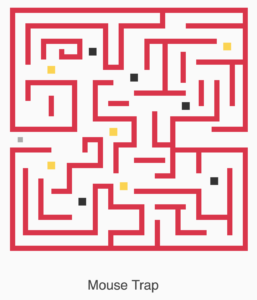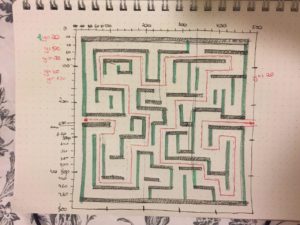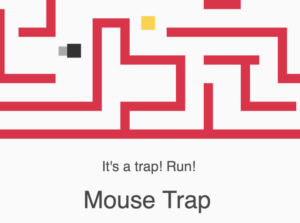Find the folder with my game here.
For this assignment, we had to create a simple game that would reflect the uniting “escape” theme. My game is called “Mouse Trap” and its interpretation of the chosen concept is quite straightforward. I gave up on my initial idea posted as a game proposal after receiving feedback from Sarah, which made me rethink my implementation of the escape concept in a play experience. So, my new plan was to create a confined space where the player has to figure out a way of breaking free. After some brainstorming, I thought of the common cognitive learning experiment done with mice in which they have to learn how to navigate a maze in order to find food. I have decided to use this real-life situation as my game design.

The canvas has a labyrinth made of vertical and horizontal rectangles. First, I have tried to copy a maze pattern from a picture that I found online, but it was rather confusing and challenging to position blocks to reflect the original image. Then I thought of generating a random maze design, but I have realized that random placement of walls does not guarantee a certain level of difficulty to the pattern. That’s why I have designed the layout myself on a piece of paper and calculated the locations of each wall. Ironically, this is where the game became difficult for its own creator. Positioning sprites turned out to be very-very time-consuming and tedious. My simple game seems unnecessarily complicated if you glance at the code, which has more than 300 lines just of the wall positioning and coloring. However, after hours of monotonous work I had the labyrinth that I imagined it.

In “Mouse Trap”, the player uses arrow keys to control a grey square that represents the mouse. It moves with a constant speed and the one and only challenge for the mouse is to find its way out of the maze. In order to complicate the game, I have also included certain obstacles on the way that either the player can use in a strategic manner or it can simply make the play experience more dynamic. The labyrinth contains 10 objects: 5 yellow squares that represent cheese and 5 black squares that represent the mouse trap. As the player hits those objects, the speed of the mouse is affected. Cheese slows it down, which is my funny metaphor for being full with food that can be used to focus on the entire layout of the labyrinth, to have some extra time to look around where the mouse should go next. The mouse traps, on the other hand, make the mouse run away from them, so the speed increases and the movement becomes very anxious – truly reflecting the movement of a real mouse in the experiment. The traps complicate the game by disrupting its flow and making the player more concerned with the direction of the mouse rather than the bigger picture of finding a way out of the labyrinth.
These additions to the game may not be understood by the user because of the abstract design, so I have added comments below the maze to imply what happens when the mouse sprite collides with a cheese square or a trap. Also, the mouse changes its color to black when it collides with the walls and the comment bar shows “Be careful!”. Initially, I wanted the collision with the walls to be either the end of the game or a loss of a “life”, but in the process of creating and testing my game, I decided to leave it as an experience of figuring out a puzzle rather than making a race out of it. For the same reason I did not make this game tied to a time limit or a high score. Besides, having a high score makes the user try again, yet the more you go through a labyrinth, the easier it becomes to escape it. So, this would mean that I’d have to design another labyrinth variation, which would take way too much time.

I think of my game as a man-made artifact produced by yours truly, which reflects my own input in its creation and design. More importantly, it reflects and is inspired by a real-life concept of a mouse put into a labyrinth to learn how to get out of it. The usage of this metaphor makes this particular play experience a cultural artifact of a scientific practice. Plus, having the game reflect a theme chosen by a group of people makes it an artifact that conveys a certain meaning understood in a specific context (our class). This game carries an idea and a meaning shared between people, which makes it a cultural artifact.
In conclusion, I would like to say that I wish I had more time to work on this game and maybe implement some of the suggestions I have received in class. Potentially, the game could also include a cat chasing the mouse, or the cat could be one of the game objects that the mouse had to avoid colliding with.